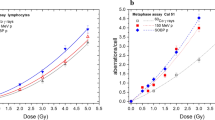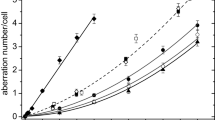Abstract
The relative biological effectiveness (RBE) based on the induction of dicentrics in any cell type is principally an important information for the increasing application of high-LET radiation in cancer therapy. Since the standard system of human lymphocytes for measuring dicentrics are not compatible with our microbeam irradiation setup where attaching cells are essential, we used human–hamster hybrid AL cells which do attach on foils and fulfil the special experimental requirement for microbeam irradiations. In this work, the dose–response of AL cells to photons of different energy, 70 and 200 kV X-rays and 60Co γ-rays, is characterized and compared to human lymphocytes. The total number of induced dicentrics in AL cells is approximately one order of magnitude smaller. Despite the smaller α and β parameters of the measured linear–quadratic dose–response relationship, the α/β-ratio versus photon energy dependence is identical within the accuracy of measurement for AL cells and human lymphocytes. Thus, the influence of the reference radiation used for RBE determination is the same. For therapy relevant doses of 2 Gy (60Co equivalent), the difference in RBE is around 20% only. These findings indicate that the biological effectiveness in AL cells can give important information for human cells, especially for studies where attaching cells are essential.




Similar content being viewed by others
References
BEIR VII Report (2006) Health risks from exposure to low levels of ionizing radiation. National Academies Press, Washington, DC
Dollinger G, Bergmaier A, Hable V, Hertenberger R, Greubel C, Hauptner A, Reichart P (2009) Nanosecond proton microbeam. Nucl Instrum Methods Phys Res B 267:2008–2012
Gumrich K, Virsik-Peukert RP, Harder D (1986) Temperature and the formation of radiation-induced chromosome aberrations. I. The effect of radiation temperature. Int J Radiat Biol 49:665–672
Hintzsche H, Jastrow C, Kleine-Ostmann T, Stopper H, Schmid E, Schrader T (2011) Terahertz radiation induces spindle disturbances in human-hamster hybrid cells. Radiat Res 175:569–574
IAEA (2001) Cytogenetic analysis for radiation dose assessment. IAEA technical report series 405, Vienna
IAEA (2008) Relative biological effectiveness in ion beam therapy. IAEA technical report series 461, Vienna
ICRP (2003) Relative biological effectiveness (RBE), quality factor (Q), and radiation weighting factor (wR). Annals of the ICRP; Publication 92, Pergamon Press, Oxford
Krumrey M, Ulm G, Schmid E (2004) Dicentric chromosomes in monolayer of human lymphocytes produced by monochromatized synchrotron radiation with photon energies from 1.83 keV to 17.4 keV. Radiat Environ Biophys 43:1–6
Ku H (1966) Notes on the use of propagation of error formulas. J Res Nat Bur Stand 70:263–273
Martin M (2009) Laser accelerated radiotherapy: is it on its way to the clinic? J Natl Cancer Inst 101:450–451
Sasaki MS (1991) Primary damage and fixation of chromosomal DNA as probed by monochromatic soft X-rays and low-energy neutrons. In: Fielden EM, O’Neil P (Eds.) The early effects of radiation on DNA. NATO ASI Series, vol H54. Springer, Berlin (Germany) pp 369–384
Sasaki MS, Kobayashi K, Hieda K, Yamada T, Ejima Y, Maezawa H, Furusawa Y, Ito T, Okada S (1989) Induction of chromosome aberrations in human lymphocytes by monochromatic X-rays of quantum energy between 4.8 and 14.6 keV. Int J Radiat Biol 56:975–988
Schmid E, Bauchinger M, Streng S, Nahrstedt U (1984) The effect of 220 kVp X-rays with different spectra on the dose response of chromosome aberrations in human lymphocytes. Radiat Environ Biophys 23:305–309
Schmid E, Braselmann H, Nahrstedt U (1995) Comparison of gamma-ray induced dicentric yields in human lymphocytes measured by conventional analysis and FISH. Mutat Res 348:125–130
Schmid E, Hieber L, Heinzmann U, Roos H, Kellerer AM (1996) Analysis of chromosome aberrations in human peripheral lymphocytes induced by in vitro a- particle irradiation. Radiat Environ Biophys 35:179–184
Schmid E, Schraube H, Bauchinger M (1998) Chromosome aberration frequencies in human lymphocytes irradiated in a phantom by a mixed beam of fission neutrons and gamma rays (1998). Int J Radiat Biol 73:263–267
Schmid E, Regulla D, Guldbakke S, Schlegel D, Roos M (2002a) Relative biological effectiveness of 144 keV neutrons in producing dicentric chromosomes in human lymphocytes compared with 60Co gamma rays under head-to-head conditions. Radiat Res 157:453–460
Schmid E, Regulla D, Kramer HM, Harder D (2002b) The effect of 29 kV X-rays on the dose response of chromosome aberrations in human lymphocytes. Radiat Res 158:771–777
Schmid E, Krumrey M, Ulm G, Roos H, Regulla D (2003) The maximum low-dose RBE of 17.4 and 40 keV monochromatic X-rays for the induction of dicentric chromosomes in human peripheral lymphocytes. Radiat Res 160:499–504
Schmid E, Roos H, Kramer HM (2008) The dependence of the biological effectiveness of 60Co gamma rays in a large absorber determined by dicentric chromosomes in human lymphocytes. Radiat Prot Dosim 130:442–444
Schmid E, Wagner FM, Romm H, Walsh L, Roos H (2009a) Dose-response relationship of dicentric chromosomes in human lymphocytes obtained for the fission neutron therapy facility MEDAPP at the research reactor FRM II (2009). Radiat Environ Biophys 48:67–75
Schmid TE, Dollinger G, Hauptner A, Hable V, Greubel C, Auer S, Friedl AA, Molls M, Röper B (2009b) No evidence for a different RBE between pulsed and continuous 20 MeV protons. Radiat Res 172:567–574
Schmid TE, Dollinger G, Hable V, Greubel C, Zlobinskaya O, Michalski D, Auer S, Friedl AA, Schmid E, Molls M, Röper B (2011) The effectiveness of 20 MeV protons at nanosecond pulse lengths in producing chromosome aberrations in human-hamster hybrid cells. Radiat Res 175:719–727
Schmid TE, Greubel C, Hable V, Zlobinskaya O, Michalski D, Girst S, Siebenwirth C, Schmid E, Molls M, Multhoff G, Dollinger G (2012) Low LET protons focused to submicrometer shows enhanced radiobiological effectiveness. Phys Med Biol 57:5889–5907
Schmid TE, Friedland W, Greubel C, Girst S, Reindl J, Siebenwirth C, Ilicic K, Schmid E, Multhoff G, Schmitt E, Kundrat P, Dollinger G (2015) Sub-micrometer 20 MeV protons and 45 MeV lithium spot irradiation enhances yields of dicentric chromosomes due to clustering of DNA double-strand breaks. Mutat Res 793:30–40
Schrader T, Münter K, Kleine-Ostmann T, Schmid E (2008) Spindle disturbances in human-hamster hybrid (AL) cells induced by mobile communication frequency range signals. Bioelectromagnetics 29:626–639
Acknowledgements
This work was supported by the DFG Cluster of Excellence: Munich-Centre for Advanced Photonics and by the project ‘LET-Verbund’ (Funding Nos. 02NUK031A, 02NUK031B) of the German Federal Ministry of Education and Research.
Author information
Authors and Affiliations
Corresponding author
Appendix
Appendix
The RBE of a certain radiation quality, here called test radiation T, with respect to a reference radiation is defined as the ratio of the doses of the reference radiation, D ref, and the test radiation, D T, necessary to induce the same effect: RBE = D ref/D T. Changing the reference radiation the RBE will change, too. The RBE depends on the reference radiation. The RBE of a test radiation with respect to reference radiation B, RBErefB (T), can be expressed by the RBE with respect to reference radiation A, RBEref A (T), and the RBE of reference radiation B with respect to reference radiation A, RBEref A (B), in the following way:
Rights and permissions
About this article
Cite this article
Schmid, T.E., Greubel, C., Dollinger, G. et al. The influence of reference radiation photon energy on high-LET RBE: comparison of human peripheral lymphocytes and human–hamster hybrid AL cells. Radiat Environ Biophys 56, 79–87 (2017). https://doi.org/10.1007/s00411-016-0680-3
Received:
Accepted:
Published:
Issue Date:
DOI: https://doi.org/10.1007/s00411-016-0680-3




